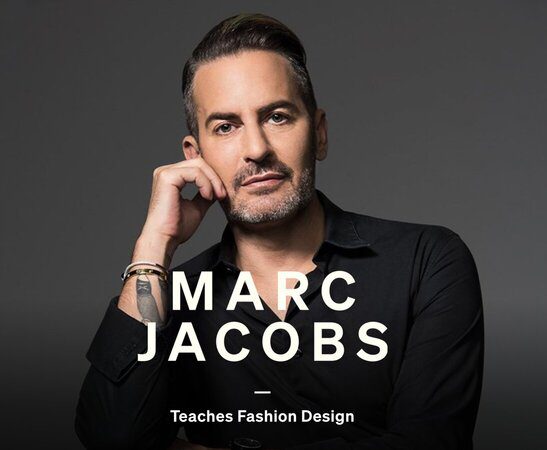Marc Jacobs is an American fashion designer from New York City. After graduating from the High School of Art and Design in 1981, Marc entered Parsons School of Design, where he stood out among his classmates by winning both the Perry Ellis Gold Thimble Award and Design Student of the Year in 1984. In 1997, Marc was appointed creative director of luxury fashion house Louis Vuitton, where he created the company’s first ready-to-wear clothing line. He is now the head designer for his own eponymous fashion label, Marc Jacobs. Marc is a five-time recipient of the Council of Fashion Designers of America’s Womenswear Designer of the Year Award.
Marc’s Fashion Journey
Marc’s love for fashion began with back-to-school shopping. His grandmother would take him to the department store where he could sort through the clothes. There were also shops for customizing clothing and Marc could play with different designs on T-shirts. Inspired by his babysitter’s jean jackets with different patches and embroideries, Marc found a love for customizing clothing himself.
This gave him an outlet for mixing his school clothing with arts and crafts. This lead him to apply to and attend the High School of Art and Design in New York, where he majored in fashion. He knew he wanted to grow within fashion design rather than fashion photography or illustration. Marc continued to grow his knowledge by reading magazines and books and skipping class to sneak into fashion and trunk shows. Part of this personal learning included studying period-specific costume design and how it affected fashion.
When he was 15, Marc began folding clothes in the stockroom of the fashion boutique Charivari so he could gain exposure to designer clothes. He worked up to becoming a salesperson, a role in which he got to meet buyers for different clothing lines. This helped him to discuss his passion with almost anyone. When Marc met Perry Ellis, Ellis advised him that if he were serious about becoming a fashion designer, he should study at Parsons.
Be Curious – Study the Great
Yves Saint Laurent was a major influence on Marc’s work. By taking inspiration from the street, collecting art, and surrounding himself with interesting people, Saint Laurent emanated glamour. With his wealth of references, Saint Laurent elevated common articles of clothing, such as a motorcycle jacket, into haute couture. You can build your mental library of references by reading fashion magazines, analyzing the work of your favorite designers, studying art and art history, and observing the world around you.
Other Influential designers: Coco Chanel (Chanel), Ralph Lauren (Polo Ralph Lauren), Roy Halston Frowick (Comme des Garçons), Dame Vivienne Westwood, Martin Margiela (Maison Margiela fashion house).Elsa Schiaparelli .
Finding Inspiration
Your job as a designer is to produce something other people will love wearing. Finding your inspiration to do this may not come easily, but Marc bolsters his creativity through trial and error. The exploratory process of sketching, selecting fabrics, or revising your first muslin may spark an idea for you, but inspiration
may change as you cast models, decide on hair and makeup, or plan how to show your collection on the runway.
Fashion is more than just the clothing you wear, but the way it is worn and the visual story it tells.
Pull inspiration from things you are genuinely interested in: music, art, history, architecture, and especially people.
THE CREATIVE PROCESS OF DESIGN
Marc describes his process as a series of creative decisions that are refined, modified, and repeated until he can express his idea in three-dimensional form. All of your creative decisions—even the details—tell a story.
Mood Boards
Instead of using one all-encompassing board to represent the garment or outfit, Marc creates multiple boards for fabrics, textures, colors, style references, and accessories. These boards are comprised of a wide range of visual references,
including editorial sources, street style, and photographs (even if they aren’t related to fashion).
Hone your voice and signature style so that your clothes are recognizable. You don’t have to stay within a particular style, as long as you make thoughtful creative decisions that aid your brand as a designer.
Mood boards are used by fashion, graphic, interior, and industrial designers, as well as photographers, to focus their visual ideas.
If you study the shapes of the past, such as the A-line skirt or the circle dress, you will see different approaches to using silhouettes to define the shape of a garment and how they fit the human body. The silhouette you choose may dictate the fabrics you work with and how you fashion them together. Your goal in the design process is to tell a cohesive story through your fabric and silhouette choices.
Don’t force something to work that just won’t. Reevaluate your design
and keep working.
The design process is not finite. You will edit, collaborate, and continue to be inspired until your garment accurately represents your vision.
Developing a Collection
Building a collection is not a linear journey. You may be deciding on fabrics, colors, embroidery ideas; creating samples and swatches; and doing research simultaneously. The only constant within this process is the series of creative choices you will need to make to bring a garment to life. Be flexible with your ideas and let the fabrics, colors, patterns, and trim inspire the next iteration.
Focus your collection to display your point of view.
Working with a team and collaboration
Throughout your career you may have the opportunity to be a part of a design team or lead one of your own. When working with teams, Marc encourages you to bring your research and ideas to the table instead of waiting for direction. Listening is a large part of collaborating effectively. You have to hear what your
teammates are saying in order to provide feedback and push your designs to evolve.
Getting Fired from Perry Ellis
When Marc was fired from Perry Ellis, he worried that he would never work again. The future for Marc and his business partner, Robert Duffy, was unclear. They were unemployed for an entire year before they were able to muster the energy, ideas, and ambition to start their own company.
Rejuvenating the Louis Vuitton brand
Yves Carcelle, president of Louis Vuitton, asked Marc to create a project that showed what he thought the brand could be beyond luggage and handbags. Marc began his research by exploring the brand’s stores and existing products. He thought about the future of Louis Vuitton, not its past. Marc decided that a womenswear and menswear collection, complete with accessories, jewelry, and shoes, was the right direction. Marc became creative and artistic director of Louis Vuitton in 1997. His main goal was to rejuvenate the Louis Vuitton brand, reshaping it to appeal to a young demographic.
Surviving the fashion industry
Your goal at the beginning of your career is to gain as much experience as you can. Ask questions, reach out to collaborators, and seek out mentors. Look for internships to get closer to the products you want to create and the customers you hope to serve. If you surround yourself with people who share your excitement and drive, you will push each other to create better products. And most people want to be around others who are excited about what they’re doing.
Search for inspiration in magazines, images online, fabrics, and conversations with people whose style you love. Use social media to spot trends within your
network and follow the content that aligns most closely with your passion.
Recommended Tools
- Polyvore acquired by SSENSE (Shutdown) – Digital Mood Board.
- Fashion design software for dress patterns – Pattern Maker USA
- Leena’s Pattern Drafting
Recommended Resources
- Helen Joseph Armstrong, Patternmaking for Fashion Design, PHI, 2009.
- Gail Baugh, The Fashion Designer’s Textile Directory: A Guide to Fabrics’ Properties, Characteristics, and Garment-Design Potential, Barron’s Educational Series, 2011.
- Jay Calderin and Laura Volpintesta, The Fashion Design Reference & Specification Book: Everything Fashion Designers Need to Know Every Day, Rockport, 2013.
- Mary Gehlhar, The Fashion Designer Survival Guide: Start and Run Your Own Fashion Business (Revised and Expanded Edition), Kaplan, 2008.
- John Hopkins, Fashion Design: The Complete Guide, AVA, 2012.
- Pamela Golbin, Louis Vuitton/Marc Jacobs, Exhibition catalog published in association with the Musée des Arts Décoratifs, Paris, Rizzoli, 2012.
- Reader’s Digest’s New Complete Guide to Sewing: Step-by-Step Techniques for Making Clothes and Home Accessories
- Derek Ridger, We’re Desperate: The Punk Rock Photography of Jim Jocoy, powerHouse Books, 2002.
- Paul Gorman, Mr. Freedom: Tommy Roberts: British Design Hero, Adelita, 2012.
- Vintage issues of Stitchcraft and Vogue Knitting.
- Issues of Vogue Italia, Vogue UK, and ELLE from the 1970s, 1980s, and 1990s
- Elinor and Colin Renfrew’s Developing a Fashion Collection

MasterClass is a streaming platform that makes it possible for anyone to learn from the very best. MasterClass is an online membership – accessible on your phone, web, Apple TV, Roku devices, and Amazon Fire TV – that offers classes on a wide variety of topics taught by 90+ world-class masters at the top of their fields.
Their immersive learning experiences combine incredible video content, downloadable materials, and social interaction with the MasterClass community, all of which users can explore at their own pace.
The annual membership is available for $180 USD, which allows unlimited access to ALL on demand MasterClass content for the year
Give One Annual Membership. Get One Free.
All the best in your quest to get better. Don’t Settle: Live with Passion.
For More Information: MasterClass Home Page



Comments are closed.